More on spectrum analysis
Computerized Fourier analysis, particularly
in the form of the FFT algorithm, is a powerful tool
for furthering our understanding of waveforms and their
related spectral components. This same mathematical routine
programmed into the SPICE simulator as the .fourier
option is also programmed into a variety of electronic test
instruments to perform real-time Fourier analysis on
measured signals. This section is devoted to the use of such
tools and the analysis of several different waveforms.
First we have a simple sine wave at a
frequency of 523.25 Hz. This particular frequency value is a
"C" pitch on a piano keyboard, one octave above "middle C".
Actually, the signal measured for this demonstration was
created by an electronic keyboard set to produce the tone of
a panflute, the closest instrument "voice" I could find
resembling a perfect sine wave. The plot below was taken
from an oscilloscope display, showing signal amplitude
(voltage) over time:

Viewed with an oscilloscope, a sine wave
looks like a wavy curve traced horizontally on the screen.
The horizontal axis of this oscilloscope display is marked
with the word "Time" and an arrow pointing in the direction
of time's progression. The curve itself, of course,
represents the cyclic increase and decrease of voltage over
time.
Close observation reveals imperfections in
the sine-wave shape. This, unfortunately, is a result of the
specific equipment used to analyze the waveform.
Characteristics like these due to quirks of the test
equipment are technically known as artifacts:
phenomena existing solely because of a peculiarity in the
equipment used to perform the experiment.
If we view this same AC voltage on a
spectrum analyzer, the result is quite different:
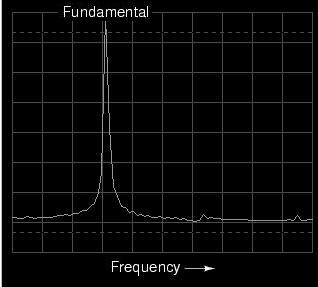
As you can see, the horizontal axis of the
display is marked with the word "Frequency," denoting the
domain of this measurement. The single peak on the curve
represents the predominance of a single frequency within the
range of frequencies covered by the width of the display. If
the scale of this analyzer instrument were marked with
numbers, you would see that this peak occurs at 523.25 Hz.
The height of the peak represents the signal amplitude
(voltage).
If we mix three different sine-wave tones
together on the electronic keyboard (C-E-G, a C-major chord)
and measure the result, both the oscilloscope display and
the spectrum analyzer display reflect this increased
complexity:
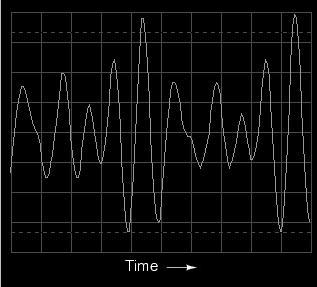
The oscilloscope display (time-domain) shows
a waveform with many more peaks and valleys than before, a
direct result of the mixing of these three frequencies. As
you will notice, some of these peaks are higher than the
peaks of the original single-pitch waveform, while others
are lower. This is a result of the three different waveforms
alternately reinforcing and canceling each other as their
respective phase shifts change in time.
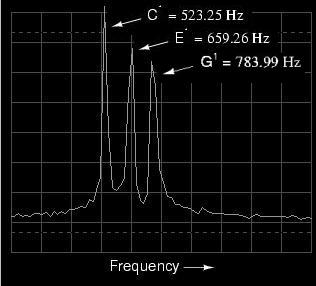
The spectrum display (frequency-domain) is
much easier to interpret: each pitch is represented by its
own peak on the curve. The difference in height between
these three peaks is another artifact of the test equipment:
a consequence of limitations within the equipment used to
generate and analyze these waveforms, and not a necessary
characteristic of the musical chord itself.
As was stated before, the device used to
generate these waveforms is an electronic keyboard: a
musical instrument designed to mimic the tones of many
different instruments. The panflute "voice" was chosen for
the first demonstrations because it most closely resembled a
pure sine wave (a single frequency on the spectrum analyzer
display). Other musical instrument "voices" are not as
simple as this one, though. In fact, the unique tone
produced by any instrument is a function of its
waveshape (or spectrum of frequencies). For example, let's
view the signal for a trumpet tone:
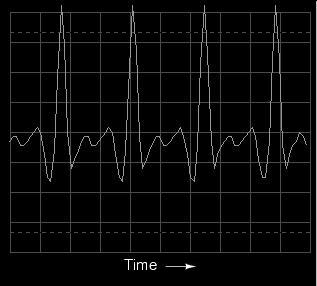
The fundamental frequency of this tone is
the same as in the first panflute example: 523.25 Hz, one
octave above "middle C." The waveform itself is far from a
pure and simple sine-wave form. Knowing that any repeating,
non-sinusoidal waveform is equivalent to a series of
sinusoidal waveforms at different amplitudes and
frequencies, we should expect to see multiple peaks on the
spectrum analyzer display:
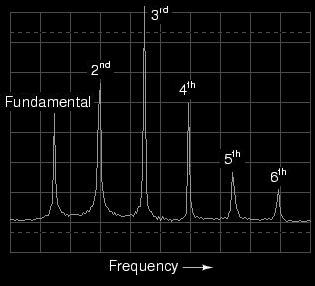
Indeed we do! The fundamental frequency
component of 523.25 Hz is represented by the left-most peak,
with each successive harmonic represented as its own peak
along the width of the analyzer screen. The second harmonic
is twice the frequency of the fundamental (1046.5 Hz), the
third harmonic three times the fundamental (1569.75 Hz), and
so on. This display only shows the first six harmonics, but
there are many more comprising this complex tone.
Trying a different instrument voice (the
accordion) on the keyboard, we obtain a similarly complex
oscilloscope (time-domain) plot and spectrum analyzer
(frequency-domain) display:
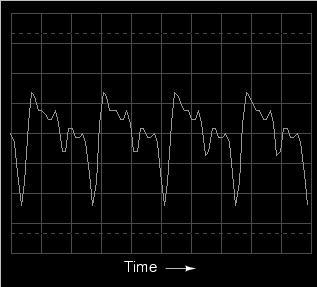
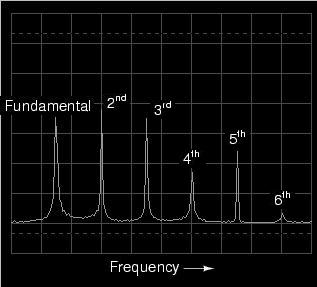
Note the differences in relative harmonic
amplitudes (peak heights) on the spectrum displays for
trumpet and accordion. Both instrument tones contain
harmonics all the way from 1st (fundamental) to 6th (and
beyond!), but the proportions aren't the same. Each
instrument has a unique harmonic "signature" to its tone.
Bear in mind that all this complexity is in reference to
a single note played with these two instrument "voices."
Multiple notes played on an accordion, for example, would
create a much more complex mixture of frequencies than what
is seen here.
The analytical power of the oscilloscope and
spectrum analyzer permit us to derive general rules about
waveforms and their harmonic spectra from real waveform
examples. We already know that any deviation from a pure
sine-wave results in the equivalent of a mixture of multiple
sine-wave waveforms at different amplitudes and frequencies.
However, close observation allows us to be more specific
than this. Note, for example, the time- and frequency-domain
plots for a waveform approximating a square wave:
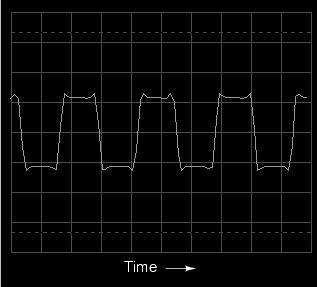
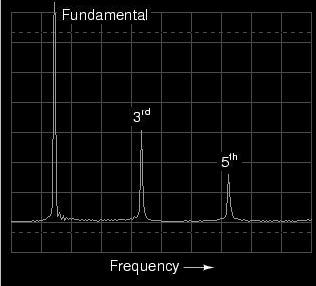
According to the spectrum analysis, this
waveform contains no even harmonics, only odd.
Although this display doesn't show frequencies past the
sixth harmonic, the pattern of odd-only harmonics in
descending amplitude continues indefinitely. This should
come as no surprise, as we've already seen with SPICE that a
square wave is comprised of an infinitude of odd harmonics.
The trumpet and accordion tones, however, contained both
even and odd harmonics. This difference in harmonic content
is noteworthy. Let's continue our investigation with an
analysis of a triangle wave:
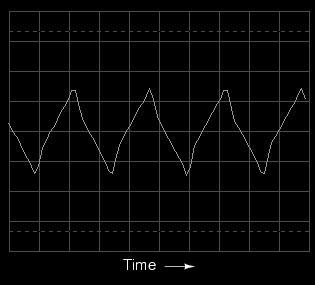
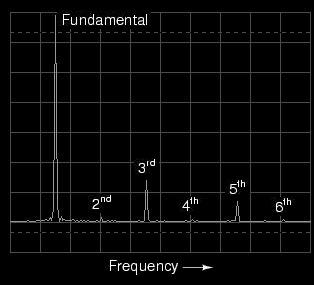
In this waveform there are practically no
even harmonics: the only significant frequency peaks on the
spectrum analyzer display belong to odd-numbered multiples
of the fundamental frequency. Tiny peaks can be seen for the
second, fourth, and sixth harmonics, but this is due to
imperfections in this particular triangle waveshape (once
again, artifacts of the test equipment used in this
analysis). A perfect triangle waveshape produces no even
harmonics, just like a perfect square wave. It should be
obvious from inspection that the harmonic spectrum of the
triangle wave is not identical to the spectrum of the square
wave: the respective harmonic peaks are of different
heights. However, the two different waveforms are common in
their lack of even harmonics.
Let's examine another waveform, this one
very similar to the triangle wave, except that its rise-time
is not the same as its fall-time. Known as a sawtooth
wave, its oscilloscope plot reveals it to be aptly
named:
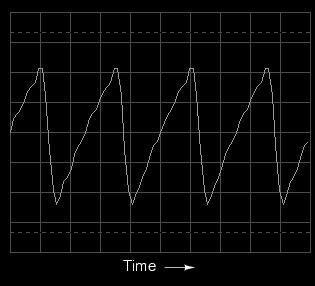
When the spectrum analysis of this waveform
is plotted, we see a result that is quite different from
that of the regular triangle wave, for this analysis shows
the strong presence of even-numbered harmonics (second and
fourth):
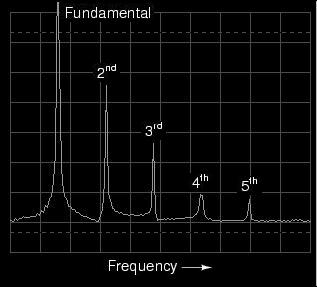
The distinction between a waveform having
even harmonics versus no even harmonics resides in the
difference between a triangle waveshape and a sawtooth
waveshape. That difference is symmetry above and
below the horizontal centerline of the wave. A waveform that
is symmetrical above and below its centerline (the shape on
both sides mirror each other precisely) will contain no
even-numbered harmonics.
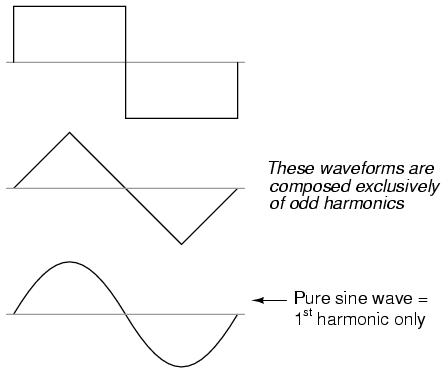
Square waves, triangle waves, and pure sine
waves all exhibit this symmetry, and all are devoid of even
harmonics. Waveforms like the trumpet tone, the accordion
tone, and the sawtooth wave are unsymmetrical around their
centerlines and therefore do contain even harmonics.
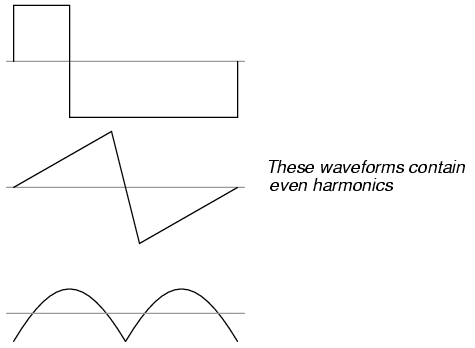
This principle of centerline symmetry should
not be confused with symmetry around the zero line.
In the examples shown, the horizontal centerline of the
waveform happens to be zero volts on the time-domain graph,
but this has nothing to do with harmonic content. This rule
of harmonic content (even harmonics only with unsymmetrical
waveforms) applies whether or not the waveform is shifted
above or below zero volts with a "DC component." For further
clarification, I will show the same sets of waveforms,
shifted with DC voltage, and note that their harmonic
contents are unchanged.
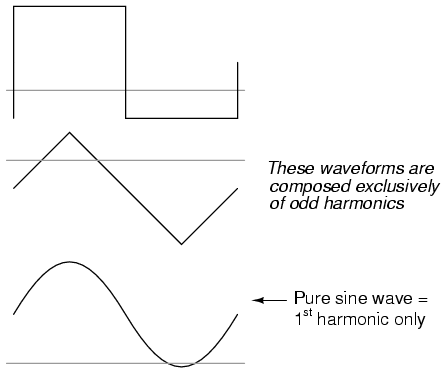
Again, the amount of DC voltage present in a
waveform has nothing to do with that waveform's harmonic
frequency content.
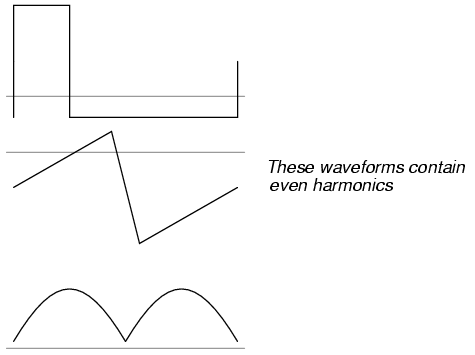
Why is this harmonic rule-of-thumb an
important rule to know? It can help us comprehend the
relationship between harmonics in AC circuits and specific
circuit components. Since most sources of sine-wave
distortion in AC power circuits tend to be symmetrical,
even-numbered harmonics are rarely seen in those
applications. This is good to know if you're a power system
designer and are planning ahead for harmonic reduction: you
only have to concern yourself with mitigating the odd
harmonic frequencies, even harmonics being practically
nonexistent. Also, if you happen to measure even harmonics
in an AC circuit with a spectrum analyzer or frequency
meter, you know that something in that circuit must be
unsymmetrically distorting the sine-wave voltage or
current, and that clue may be helpful in locating the source
of a problem (look for components or conditions more likely
to distort one half-cycle of the AC waveform more than the
other).
Now that we have this rule to guide our
interpretation of nonsinusoidal waveforms, it makes more
sense that a waveform like that produced by a rectifier
circuit should contain such strong even harmonics, there
being no symmetry at all above and below center.
-
REVIEW:
-
Waveforms that are symmetrical above and
below their horizontal centerlines contain no
even-numbered harmonics.
-
The amount of DC "bias" voltage present (a
waveform's "DC component") has no impact on that wave's
harmonic frequency content.
|